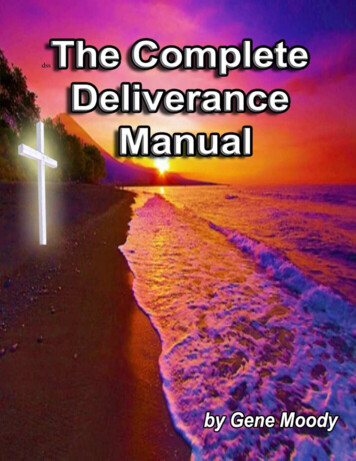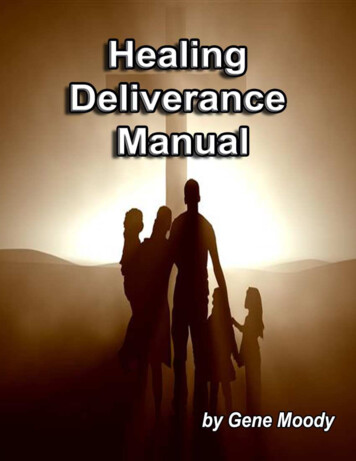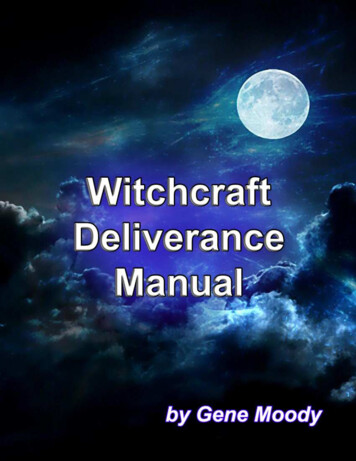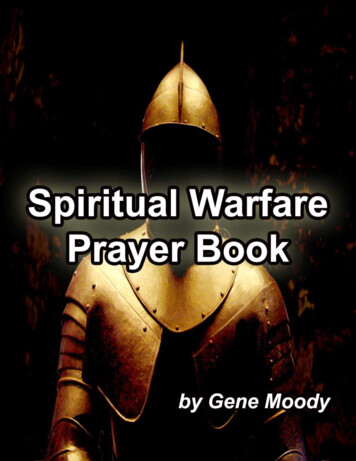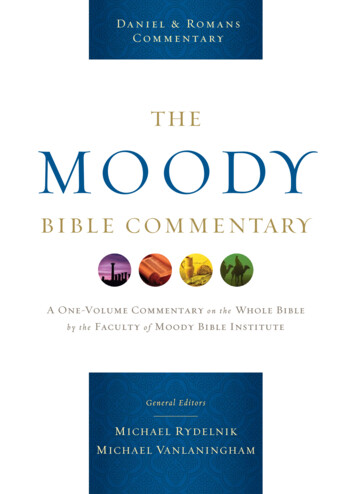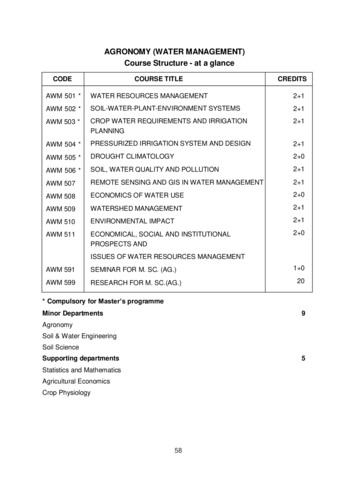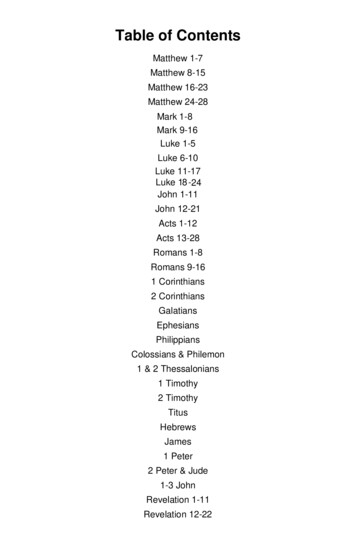
Transcription
Table of ContentsMatthew 1-7Matthew 8-15Matthew 16-23Matthew 24-28Mark 1-8Mark 9-16Luke 1-5Luke 6-10Luke 11-17Luke 18 -24John 1-11John 12-21Acts 1-12Acts 13-28Romans 1-8Romans 9-161 Corinthians2 CorinthiansGalatiansEphesiansPhilippiansColossians & Philemon1 & 2 Thessalonians1 Timothy2 TimothyTitusHebrewsJames1 Peter2 Peter & Jude1-3 JohnRevelation 1-11Revelation 12-22
MATTHEW 1-7MOODY PUBLISHERS/CHICAGOMNTC Matthew 1-7 complete.2.indd 18/6/15 2:27 PM
.16.17.18.PAGEPreface . . . . . . . . . . . . . . . . . . . . . . . . . . . . . . . . . . . . . . . . . . . . . . . . . . . . viiIntroduction . . . . . . . . . . . . . . . . . . . . . . . . . . . . . . . . . . . . . . . . . . . . . . . . . ixThe Gracious King (Matthew 1:1-17) . . . . . . . . . . . . . . . . . . . . . . . . . . . . . 1The Virgin Birth (Matthew 1:18-25) . . . . . . . . . . . . . . . . . . . . . . . . . . . . . 11Fools and Wise Men (Matthew 2:1-12) . . . . . . . . . . . . . . . . . . . . . . . . . . 23The King Fulfills Prophecy (Matthew 2:13-23) . . . . . . . . . . . . . . . . . . . . 39The Greatest Man (Matthew 3:1- 6) . . . . . . . . . . . . . . . . . . . . . . . . . . . . . . 49The Fruits of True Repentance (Matthew 3:7-12) . . . . . . . . . . . . . . . . . . 59The Coronation of the King (Matthew 3:13-17) . . . . . . . . . . . . . . . . . . . . 73The Crisis of Temptation (Matthew 4:1-11) . . . . . . . . . . . . . . . . . . . . . . . 83The Light Dawns (Matthew 4:12-17) . . . . . . . . . . . . . . . . . . . . . . . . . . . 101Fishing for Men (Matthew 4:18-22) . . . . . . . . . . . . . . . . . . . . . . . . . . . . 111The King’s Divine Credentials (Matthew 4:23- 25) . . . . . . . . . . . . . . . . . 121The Great Sermon of the Great King (Matthew 5:1-2) . . . . . . . . . . . . . . 131Happy Are the Humble (Matthew 5:3) . . . . . . . . . . . . . . . . . . . . . . . . . . 141Happy Are the Sad (Matthew 5:4) . . . . . . . . . . . . . . . . . . . . . . . . . . . . . . 153Happy Are the Meek (Matthew 5:5) . . . . . . . . . . . . . . . . . . . . . . . . . . . . . 167Happy Are the Hungry (Matthew 5:6) . . . . . . . . . . . . . . . . . . . . . . . . . . 177Happy Are the Merciful (Matthew 5:7) . . . . . . . . . . . . . . . . . . . . . . . . . . 187Happy Are the Holy (Matthew 5:8) . . . . . . . . . . . . . . . . . . . . . . . . . . . . . 199MNTC Matthew 1-7 complete.2.indd 58/6/15 2:27 PM
19. Happy Are the Peacemakers (Matthew 5:9) . . . . . . . . . . . . . . . . . . . . . . . 20920. Happy Are the Harassed (Matthew 5:10-12) . . . . . . . . . . . . . . . . . . . . . . 21921. Salt of the Earth and Light of the World (Matthew 5:13-16) . . . . . . . . . 23522. Christ and the Law—part 1The Preeminence of Scripture (Matthew 5:17) . . . . . . . . . . . . . . . . . . 24923. Christ and the Law—part 2The Permanence of Scripture (Matthew 5:18) . . . . . . . . . . . . . . . . . . . 26124. Christ and the Law—part 3The Pertinence of Scripture (Matthew 5:19) . . . . . . . . . . . . . . . . . . . . 26725. Christ and the Law—part 4The Purpose of Scripture (Matthew 5:20) . . . . . . . . . . . . . . . . . . . . . . 27526. The Attitude Behind the ActAn Overview of (Matthew 5:21-48) . . . . . . . . . . . . . . . . . . . . . . . . . . . 28327. Who Is a Murderer? (Matthew 5:21-26) . . . . . . . . . . . . . . . . . . . . . . . . . 28928. Who Is an Adulterer? (Matthew 5:27-30) . . . . . . . . . . . . . . . . . . . . . . . . 29929. Divorce and Remarriage (Matthew 5:31-32) . . . . . . . . . . . . . . . . . . . . . . 30730. The Spiritual Credibility Gap (Matthew 5:33-37) . . . . . . . . . . . . . . . . . . 31931. An Eye for an Eye (Matthew 5:38-42) . . . . . . . . . . . . . . . . . . . . . . . . . . 32732. Love Your Enemies (Matthew 5:43-48) . . . . . . . . . . . . . . . . . . . . . . . . . 33733. Giving Without Hypocrisy (Matthew 6:1-4) . . . . . . . . . . . . . . . . . . . . . . 35134. Praying Without Hypocrisy (Matthew 6:5-8) . . . . . . . . . . . . . . . . . . . . . 36135. The Disciples’ Prayer—part 1 (Matthew 6:9-15) . . . . . . . . . . . . . . . . . . 37136. The Disciples’ Prayer—part 2 (Matthew 6:9-15) . . . . . . . . . . . . . . . . . . . 38737. Fasting Without Hypocrisy (Matthew 6:16-18) . . . . . . . . . . . . . . . . . . . . 39938. Treasure in Heaven (Matthew 6:19-24) . . . . . . . . . . . . . . . . . . . . . . . . . . 40739. Overcoming Worry (Matthew 6:25-34) . . . . . . . . . . . . . . . . . . . . . . . . . 41740. Stop Criticizing (Matthew 7:1-6) . . . . . . . . . . . . . . . . . . . . . . . . . . . . . . 42941. Start Loving (Matthew 7:7-12) . . . . . . . . . . . . . . . . . . . . . . . . . . . . . . . . 44142. Which Way to Heaven? (Matthew 7:13-14) . . . . . . . . . . . . . . . . . . . . . . 44943. Beware of False Prophets (Matthew 7:15-20) . . . . . . . . . . . . . . . . . . . . . 45944. Empty Words and Empty Hearts (Matthew 7:21-29) . . . . . . . . . . . . . . . 473Bibliography . . . . . . . . . . . . . . . . . . . . . . . . . . . . . . . . . . . . . . . . . . . . . . . 491Index of Hebrew/Aramaic Words . . . . . . . . . . . . . . . . . . . . . . . . . . . . . . 493Index of Greek Words . . . . . . . . . . . . . . . . . . . . . . . . . . . . . . . . . . . . . . . 493Index of Scripture . . . . . . . . . . . . . . . . . . . . . . . . . . . . . . . . . . . . . . . . . . . 494Index of Subjects . . . . . . . . . . . . . . . . . . . . . . . . . . . . . . . . . . . . . . . . . . . 504MNTC Matthew 1-7 complete.2.indd 68/6/15 2:27 PM
The Gracious King(Matthew1:1-17)1The book of the genealogy of Jesus Christ, the son of David, the son ofAbraham.To Abraham was born Isaac; and to Isaac, Jacob; and to Jacob, Judahand his brothers; and to Judah were born Perez and Zerah by Tamar; and toPerez was born Hezron; and to Hezron, Ram; and to Ram was bornAmminadab; and to Amminadab, Nahshon; and to Nahshon, Salmon; and toSalmon was born Boaz by Rahab; and to Boaz was born Obed by Ruth; and toObed, Jesse; and to Jesse was born David the king. And to David was bornSolomon by her who had been the wife of Uriah; and to Solomon was bornRehoboam; and to Rehoboam, Abijah; and to Abijah, Asa; and to Asa wasborn Jehoshaphat; and to Jehoshaphat, Joram; and to joram, Uzziah; and toUzziah was born Jotham; and to Jotham, Ahaz; and to Ahaz, Hezekiah; and toHezekiah was born Manasseh; and to Manasseh, Amon; and to Amon, Josiah;and to Josiah were born Jeconiah and his brothers, at the time of thedeportation to Babylon.And after the deportation to Babylon, to Jeconiah was born Shealtiel;and to Shealtiel, Zerubbabel; and to Zerubbabel was born Abiud; and toAbiud, Eliakim; and to Eliakim, Azor; and to Azor was born Zadok; and toZadok, Achim; and to Achim, Eliud; and to Eliud was born Eleazar; and toEleazar, Matthan; and to Matthan, Jacob; and to Jacob was born Joseph the1MNTC Matthew 1-7 complete.2.indd 18/6/15 2:27 PM
1:1-17MATTHEWhusband of Mary, by whom was born Jesus, who is called Christ.Therefore all the generations from Abraham to David are fourteen generations; and from David to the deportation to Babylon fourteengenerations; and from the deportation to Babylon to the time of Christfourteen generations. (1:1-17)As discussed in the introduction, one of Matthew’s major purposes in hisgospel, and the primary purpose of chapters 1 and 2, is to establish Jesus’ rightto Israel’s kingship. To any honest observer, and certainly to Jews who knew andbelieved their own Scriptures, these two chapters vindicate Jesus’ claim beforePilate: “You say correctly that I am a king. For this I have been born, and for thisI have come into the world” (John 18:37).Consistent with that purpose of revealing Jesus to be the Christ (Messiah)and the King of the Jews, Matthew begins his gospel by showing Jesus’ lineagefrom the royal line of Israel. If Jesus is to be heralded and proclaimed king theremust be proof that He comes from the recognized royal family.Messiah’s royal line began with David. Through the prophet Nathan, Godpromised that it would be David’s descendants through whom He would bringthe great King who would ultimately reign over Israel and establish His eternalkingdom (2 Sam. 7:12-16). The promise was not fulfilled in Solomon, David’s sonwho succeeded him, or in any other king who ruled in Israel or Judah; and thepeople waited for another one to be born of David’s line to fulfill the prophecy. Atthe time Jesus was born the Jews were still anticipating the arrival of the promisedmonarch and the restored glory of the kingdom.The Jews’ concern for pedigrees, however, existed long before they hada king. After they entered Canaan under Joshua and conquered the region Godhad promised to them, the land was carefully and precisely divided into territories for each tribe—except the priestly tribe of Levi, for whom special cities weredesignated. In order to know where to live, each Israelite family had to determineaccurately the tribe to which it belonged (see Num. 26; 34-35). And in order toqualify for priestly function, a Levite had to prove his descent from Levi. Afterthe return from exile in Babylon, certain “sons of the priests” were not allowedto serve in the priesthood because “their ancestral registration . . . could not belocated” (Ezra 2:61-62).The transfer of property also required accurate knowledge of the familytree (see, e.g., Ruth 3-4). Even under Roman rule, the census of Jews in Palestinewas based on tribe—as can be seen from the fact that Joseph and Mary wererequired to register in “Bethlehem, because he [Joseph] was of the house andfamily of David” (Luke 2:4). We learn from the Jewish historian Josephus that inNew Testament times many Jewish families maintained detailed and highly valuedancestral files. Before his conversion, the apostle Paul had been greatly concernedabout his lineage from “the tribe of Benjamin” (see Rom. 11:1; 2 Cor. 11:22; Phil.3:5). For Jews, tribal identification and line of descent were all-important.2MNTC Matthew 1-7 complete.2.indd 28/6/15 2:27 PM
The Gracious King1:1It is both interesting and significant that since the destruction of theTemple in a.d. 70 no genealogies exist that can trace the ancestry of any Jew nowliving. The primary significance of that fact is that, for those Jews who still look forthe Messiah, his lineage to David could never be established. Jesus Christ is the lastverifiable claimant to the throne of David, and therefore to the messianic line.Matthew’s genealogy presents a descending line, from Abraham throughDavid, through Joseph, to Jesus, who is called Christ. Luke’s genealogy presentsan ascending line, starting from Jesus and going back through David, Abraham,and even to “Adam, the son of God” (Luke 3:23-38). Luke’s record is apparentlytraced from Mary’s side, the Eli of Luke 3:23 probably being Joseph’s father-inlaw (often referred to as a father) and therefore Mary’s natural father. Matthew’sintent is to validate Jesus’ royal claim by showing His legal descent from Davidthrough Joseph, who was Jesus’ legal, though not natural, father. Luke’s intent isto trace Jesus’ actual royal blood ancestry through his mother, thereby establishingHis racial lineage from David. Matthew follows the royal line through David andSolomon, David’s son and successor to the throne. Luke follows the royal linethrough Nathan, another son of David. Jesus was therefore the blood descendant ofDavid through Mary and the legal descendant of David through Joseph. Genealogically, Jesus was perfectly qualified to take the throne of David.It is essential to note that in His virgin birth Jesus not only was divinelyconceived but through that miracle was protected from regal disqualification because of Joseph’s being a descendant of Jeconiah (v. 12). Because of that king’swickedness, God had declared of Jeconiah (also called Jehoiachin or Coniah) that,though he was in David’s line, “no man of his descendants will prosper, sitting onthe throne of David or ruling again in Judah” (Jer. 22:30). That curse would haveprecluded Jesus’ right to kingship had He been the natural son of Joseph, whowas in Jeconiah’s line. Jesus’ legal descent from David, which was always tracedthrough the father, came through Jeconiah to Joseph. But His blood descent, andHis human right to rule, came through Mary, who was not in Jeconiah’s lineage.Thus the curse on Jeconiah’s offspring was circumvented, while still maintainingthe royal privilege.The book of the genealogy of Jesus Christ, the son of David, the son ofAbraham. (1:1)Biblos (book) can also refer to a record or account, as is the case here.Matthew is giving a brief record of the genealogy (genesis, “beginning, origin”)of Jesus Christ. Jesus is from the Greek equivalent of Jeshua, or Jehoshua, whichmeans “Jehovah (Yahweh) saves.” It was the name the angel told Joseph to give tothe Son who had been miraculously conceived in his betrothed, Mary, because thisOne who would soon be born would indeed “save His people from their sins” (Matt.1:21). Christos(Christ) is the Greek form of the Hebrew māshîah (Eng., messiah),which means “anointed one.” Israel’s prophets, priests, and kings were anointed,3MNTC Matthew 1-7 complete.2.indd 38/6/15 2:27 PM
1:16MATTHEWand Jesus was anointed as all three. He was the Anointed One, the Messiah, whomthe Jews had long expected to come as their great deliverer and monarch.Yet because of their unbelief and misunderstanding of Scripture, manyJews refused to recognize Jesus as the Christ, the Messiah. Some rejected Himfor the very reason that His parents were known to them. When He went backto His hometown of Nazareth He “began teaching them in their synagogue, sothat they became astonished, and said, ‘Where did this man get this wisdom,and these miraculous powers? Is not this the carpenter’s son? Is not His mothercalled Mary, and His brothers, James and Joseph and Simon and Judas? And Hissisters, are they not all with us?’ ” (Matt. 13:54-56). On another occasion, othersin Jerusalem said of Jesus, “The rulers do not really know that this is the Christ,do they? However, we know where this man is from; but whenever the Christmay come, no one knows where He is from” (John 7:26-27). A short while later,“Some of the multitude therefore, when they heard these words, were saying,‘This certainly is the Prophet.’ Others were saying, ‘This is the Christ.’ Still otherswere saying, ‘Surely the Christ is not going to come from Galilee, is He?’ ” (John7:40-41). Still others, better taught in the Scriptures but unaware of Jesus’ lineageand birthplace, said, “Has not the Scripture said that the Christ comes from theoffspring of David, and from Bethlehem, the village where David was?” (v. 42).The genealogy establishes the Messiah’s royal lineage. Matthew’s intent isnot to have the reader digress into a study of each person listed, but is to showthat all of these persons point to the royalty of Christ.The Gracious KingEven so, from Matthew’s genealogy we learn more than Jesus’ lineage. Wealso see beautiful reflections of God’s grace. Jesus was sent by a God of grace tobe a King of grace. He would not be a King of law and of iron force, but a King ofgrace. His royal credentials testify of royal grace. And the people He chose to beHis ancestors reveal the wonder of grace, and give hope to all sinners.The graciousness of this King and of the God who sent Him can be seenin the genealogy in four places and ways. We will look at these in logical, ratherthan chronological, order.THE GRACE OF GOD SEEN IN THE CHOICE OF ONE WOMANAnd to Jacob was born Joseph the husband of Mary, by whom was born Jesus,who is called Christ. (1:16)God showed His grace to Mary by choosing her to be the mother of Jesus.Although descended from the royal line of David, Mary was an ordinary, unknownyoung woman. Contrary to claims of her own immaculate conception (her beingconceived miraculously in her own mother’s womb), Mary was just as much a sinner as all other human beings ever born. She was likely much better, morally and4MNTC Matthew 1-7 complete.2.indd 48/6/15 2:27 PM
The Gracious King1:16spiritually, than most people of her time, but she was not sinless. She was deeplydevout and faithful to the Lord, as she demonstrated by her humble and submissive response to the angel’s announcement (Luke 1:38).Mary needed a Savior, as she herself acknowledged at the very beginningof her song of praise, often called the Magnificat: “My soul exalts the Lord, andmy spirit has rejoiced in God my Savior. For He has had regard for the humblestate of His bondslave” (Luke 1:46-48). The notions of her being co-redemptrixand co-mediator with Christ are wholly unscriptural and were never a part ofearly church doctrine. Those heretical ideas came into the church several centurieslater, through accommodations to pagan myths that originated in the Babylonianmystery religions.Nimrod, a grandson of Ham, one of Noah’s three sons, founded the greatcities of Babel (Babylon), Erech, Accad, Calneh, and Nineveh (Gen. 10:10-11). Itwas at Babel that the first organized system of idolatry began with the tower builtthere. Nimrod’s wife, Semiramis, became the first high priestess of idolatry, andBabylon became the fountainhead of all evil systems of religion. In the last days,“the great harlot” will have written on her forehead, “BABYLON THE GREAT,THE MOTHER OF HARLOTS AND OF THE ABOMINATIONS OF THE EARTH”(Rev. 17:5). When Babylon was destroyed, the pagan high priest at that time fledto Pergamum (or Pergamos; called “where Satan’s throne is” in Rev. 2:13) andthen to Rome. By the fourth century a.d. much of the polytheistic paganism ofRome had found its way into the church. It was from that source that the ideas ofLent, of Mary’s immaculate conception, and of her being the “queen of heaven”originated. In the pagan legends, Semiramis was miraculously conceived by asunbeam, and her son, Tammuz, was killed and was raised from the dead afterforty days of fasting by his mother (the origin of Lent). The same basic legendswere found in counterpart religions throughout the ancient world. Semiramis wasknown variously as Ashtoreth, Isis, Aphrodite, Venus, and Ishtar. Tammuz wasknown as Baal, Osiris, Eros, and Cupid.Those pagan systems had infected Israel centuries before the coming ofChrist. It was to Ishtar, “the queen of heaven,” that the wicked and rebelliousIsraelite exiles in Egypt insisted on turning (Jer. 44:17-19; cf. 7:18). While exiledin Babylon with his fellow Jews, Ezekiel had a vision from the Lord about the“abominations” some Israelites were committing even in the Temple at Jerusalem—practices that included “weeping for Tammuz” (Ezek. 8:13-14). Here we seesome of the origins of the mother-child cult, which has drawn Mary into its grasp.The Bible knows nothing of Mary’s grace except that which she receivedfrom the Lord. She was the recipient, never the dispenser, of grace. The literaltranslation of “favored one” (Luke 1:28) is “one endued with grace.” Just as allthe rest of fallen mankind, Mary needed God’s grace and salvation. That is whyshe “rejoiced in God [her] Savior” (Luke 1:47). She received a special measure ofthe Lord’s grace by being chosen to be the mother of Jesus; but she was never asource of grace. God’s grace chose a sinful woman to have the unequaled privilegeof giving birth to the Messiah.5MNTC Matthew 1-7 complete.2.indd 58/6/15 2:27 PM
1:1MATTHEWTHE GRACE OF GOD SEEN IN THE DESCENDANTS OF TWO MENThe book of the genealogy of Jesus Christ, the son of David, the son ofAbraham. (1:1)Both David and Abraham were sinners, yet by God’s grace they wereancestors of the Messiah, the Christ.David sinned terribly in committing adultery with Bathsheba and thencompounded the sin by having her husband, Uriah, killed so that he could marryher. As a warrior he had slaughtered countless men, and for that reason was notallowed to build the Temple (1 Chron. 22:8). David was a classic example of apoor father, who failed to discipline his children, one of whom (Absalom) eventried to usurp the throne from his own father by armed rebellion.Abraham, though a man of great faith, twice lied about his wife, Sarah. Outof fear for his life and lack of trust in God, he told two different pagan kings that shewas his sister (Gen. 12:11-19; 20:1-18). In so doing he brought shame on Sarah,on himself, and on the God in whom he believed and whom he claimed to serve.Yet God made Abraham the father of His chosen people, Israel, from whomthe Messiah would arise; and He made David father of the royal line from whomthe Messiah would descend. Jesus was the Son of David by royal descent and Sonof Abraham by racial descent.God’s grace also extended to the intervening descendants of those twomen. Isaac was the son of promise, and a type of the sacrificial Savior, being himself willingly offered to God (Gen. 22:1-13). God gave the name of Isaac’s son,Jacob (later renamed Israel), to His chosen people. Jacob’s sons (Judah and hisbrothers) became heads of the tribes of Israel. All of those men were sinful andat times were weak and unfaithful. But God was continually faithful to them, andHis grace was always with them, even in times of rebuke and discipline.Solomon, David’s son and successor to the throne, was peaceful and wise,but also in many ways foolish. He sowed seeds of both domestic and spiritualcorruption by marrying hundreds of wives—most of them from pagan countriesthroughout the world of that time. They turned Solomon’s heart, and the hearts ofmany other Israelites, away from the Lord (1 Kings 11:1-8). The unity of Israel wasbroken, and the kingdom soon became divided. But the royal line remained unbroken, and God’s promise to David eventually was fulfilled. God’s grace prevailed.A careful look at the descendants both of Abraham and of David (vv. 2-16)reveals people who were often characterized by unfaithfulness, immorality, idolatry, and apostasy. But God’s dealing with them was always characterized by grace.Jesus Christ, the son of David, the son of Abraham, was sent to overcome thefailures of both those men and of all their descendants, and to accomplish whatthey could never have accomplished. The King of grace came through the line oftwo sinful men.6MNTC Matthew 1-7 complete.2.indd 68/6/15 2:27 PM
The Gracious King1:3-17THE GRACE OF GOD SEEN IN THE HISTORY OF THREE ERASTherefore all the generations from Abraham to David are fourteen generations; and from David to the deportation to Babylon fourteen generations; and from the deportation to Babylon to the time of Christ fourteengenerations. (1:17)From Matthew’s summary of the genealogy we see God’s grace at work inthree periods, or eras, of Israel’s history.The first period, from Abraham to David, was that of the patriarchs, andof Moses, Joshua, and the judges. It was a period of wandering, of enslavement ina foreign land, of deliverance, of covenant-making and law-giving, and of conquestand victory.The second period, from David to the deportation to Babylon, was thatof the monarchy, when Israel, having insisted on having human kings like all thenations around them, discovered that those kings more often led them away fromGod and into trouble than to God and into peace and prosperity. That was a periodof almost uninterrupted decline, degeneracy, apostasy, and tragedy. There wasdefeat, conquest, exile, and the destruction of Jerusalem and its Temple. Only inDavid, Jehoshaphat, Hezekiah, and Josiah do we see much evidence of godliness.The third period, from the deportation to Babylon to the time of Christ,was that of captivity, exile, frustration, and of marking time. Most of the men Matthew mentions in this period—from Shealtiel to Jacob the father of Joseph—areunknown to us apart from this list. It is a period shrouded largely in darkness andcharacterized largely by inconsequence. It was Israel’s Dark Ages.Nevertheless, God’s grace was at work on behalf of His people throughall three periods. The national genealogy of Jesus is one of mingled glory andpathos, heroism and disgrace, renown and obscurity. Israel rises, falls, stagnates,and finally rejects and crucifies the Messiah that God sent to them. But God, inHis infinite grace, yet sent His Messiah through them.THE GRACE OF GOD SEEN IN THE INCLUSION OF FOUR OUTCASTSand to Judah were born Perez and Zerah by Tamar; and to Perez wasborn Hezron; and to Hezron, Ram; and to Ram was born Amminadab;and to Amminadab, Nahshon; and to Nahshon, Salmon; and to Salmonwas born Boaz by Rahab; and to Boaz was born Obed by Ruth; and toObed, Jesse; and to Jesse was born David the king. And to David wasborn Solomon by her who had been the wife of Uriah. (1:3-6)Matthew’s genealogy also shows us the work of God’s grace in His choosing four former outcasts, each of them women (the only women listed until the7MNTC Matthew 1-7 complete.2.indd 78/6/15 2:27 PM
1:3-17MATTHEWmention of Mary), through whom the Messiah and great King would descend.These women are exceptional illustrations of God’s grace and are included for thatreason in the genealogy that otherwise is all men.The first outcast was Tamar, the Canaanite daughter-in-law of Judah.God had taken the lives of her husband, Er, and of his next oldest brother, Onan,because of their wickedness. Judah then promised the young, childless widow thathis third son, Shelah, would become her husband and raise up children in hisbrother’s name when he grew up. After Judah failed to keep that promise, Tamardisguised herself as a prostitute and tricked him into having sexual relations withher. From that illicit union were born twin sons, Perez and Zerah. The sordidstory is found in Genesis 38. As we learn from the genealogy, Tamar and Perezjoined Judah in the messianic line. Despite prostitution and incest, God’s gracefell on all three of those undeserving persons, including a desperate and deceptive Gentile harlot.The second outcast also was a woman and a Gentile. She, too, was guilty ofprostitution, but for her, unlike Tamar, it was a profession. Rahab, an inhabitant ofJericho, protected the two Israelite men Joshua sent to spy out the city. She lied tothe messengers of the king of Jericho in order to save the spies; but because of herfear of Him and her kind act toward His people, God spared her life and the lives ofher family when Jericho was besieged and destroyed (Josh. 2:1-21; 6:22-25). God’sgrace not only spared her life but brought her into the messianic line, as the wifeof Salmon and the mother of the godly Boaz, who was David’s great-grandfather.The third outcast was Ruth, the wife of Boaz. Like Tamar and Rahab, Ruthwas a Gentile. After her first husband, an Israelite, had died, she returned to Israelwith her mother-in-law, Naomi. Ruth was a godly, loving, and sensitive womanwho had accepted the Lord as her own God. Her people, the pagan Moabites, werethe product of the incestuous relations of Lot with his two unmarried daughters.In order to preserve the family line, because they had no husbands or brothers,each of the daughters got their father drunk and caused him to unknowinglyhave sexual relations with them. The son produced by Lot’s union with his oldestdaughter was Moab, father of a people who became one of Israel’s most implacableenemies. Mahlon, the Israelite man who married Ruth, did so in violation of theMosaic law (Deut. 7:3; cf. 23:3; Ezra 9:2; Neh. 13:23) and many Jewish writerssay his early death, and that of his brother, were a divine judgment on their disobedience. Though she was a Moabite and former pagan, with no right to marryan Israelite, God’s grace not only brought Ruth into the family of Israel, but later,through Boaz, into the royal line. She became the grandmother of Israel’s greatKing David.The fourth outcast was Bathsheba. She is not identified in the genealogy byname, but is mentioned simply as the wife of David and the former wife of Uriah.As already mentioned, David committed adultery with her, had her husband sent tothe battlefront to be killed, and then took her as his own wife. The son produced bythe adultery died in infancy, but the next son born to them was Solomon (2 Sam.11:1-27; 12:14, 24), successor to David’s throne and continuer of the messianic line.8MNTC Matthew 1-7 complete.2.indd 88/6/15 2:27 PM
The Gracious King1:3-17By God’s grace, Bathsheba became the wife of David, the mother of Solomon, andan ancestor of the Messiah.The genealogy of Jesus Christ is immeasurably more than a list of ancientnames; it is even more than a list of Jesus’ human forebears. It is a beautiful testimony to God’s grace and to the ministry of His Son, Jesus Christ, the friend ofsinners, who “did not come to call the righteous, but sinners” (Matt. 9:13). If Hehas called sinners by grace to be His forefathers, should we be surprised when Hecalls them by grace to be His descendants? The King presented here is truly theKing of grace!9MNTC Matthew 1-7 complete.2.indd 98/6/15 2:27 PM
MATTHEW 8-15MOODY PUBLISHERS/CHICAGOMatthew 8-15 F2.indd 17/30/15 10:17 AM
Contentschapter. pagePreface. vii1. Jesus’ Power over Disease (Matthew 8:1-15). 12. What Keeps Men from Christ? (Matthew 8:16-22). 173. Jesus’ Power over the Natural (Matthew 8:23-27). 294. Jesus’ Power over the Supernatural (Matthew 8:28-34) . 395. Jesus’ Power over Sin (Matthew 9:1-8). 476. Receiving the Sinner/Refusing the Righteous (Matthew 9:9-17) . 577. Jesus’ Power over Death (Matthew 9:18-26).
Matthew’s genealogy presents a descending line, from Abraham through David, through Joseph, to Jesus, who is called Christ. Luke’s genealogy presents an ascending line, starting from Jesus and going back through David, Abraham, and even to “Adam, th


